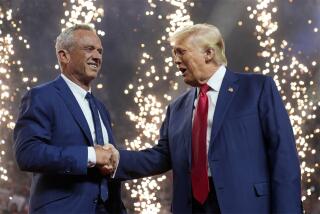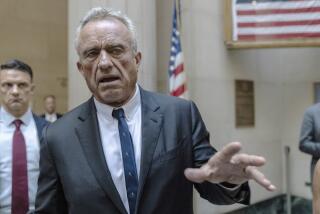Seeking Inroads on Back Roads
- Share via
GALLUP, N.M. — It was a novelty back then, two good old Southern boys and their blond wives setting off on a political road trip across America. It was quickly dubbed Bill and Al’s Excellent Adventure, and indeed it was.
In the summer of 1992, with a Bush in the White House and healthcare and the economy making people nervous, Bill Clinton and Al Gore, two men in their mid-40s, set out from the Democratic National Convention with nothing but highway and the future ahead of them.
For the record:
12:00 a.m. Aug. 12, 2004 For The Record
Los Angeles Times Thursday August 12, 2004 Home Edition Main News Part A Page 2 National Desk 1 inches; 37 words Type of Material: Correction
Candidate’s schedule -- A map in Monday’s Section A with an article about Democratic presidential nominee John F. Kerry’s cross-country tour indicated that he would campaign in Las Vegas on Monday. Kerry was in Arizona that day.
They traveled by bus, that most proletarian of vehicles, hugging the back roads and side streets of overlooked America, drawing spectacular crowds and capturing political lightning with their bare hands.
A cliche was born.
Now every politician rides the bus -- even movie star governors such as Arnold Schwarzenegger -- to show their everyman accessibility and, just maybe, kindle a bit of that 1992 magic.
The latest sojourner of the blacktop is John F. Kerry, this year’s Democratic presidential nominee, joined by running mate John Edwards for parts of a 14-day cross-country swing that has alternated between bus, boat and train as Kerry meanders his way from Boston to Los Angeles and up the coast into Oregon.
Much has changed. Much is the same.
There is a Bush in the White House once more. Healthcare and the economy are making people nervous. And Kerry’s route is again the one less traveled, through cornfields and across lonesome prairies, to the out-of-the-way places where people are thrilled to have a celebrity drop by.
“Inside I’m just, ‘Oh, I can’t believe he’s here,’ ” said Lynette Lucey, a 61-year-old elementary school teacher, who was all aflutter when Kerry stopped in tiny Cuba City, Wis., population 2,000, during one of the early legs of his trip. “I watched him at the convention and was cheering from my chair. Now to come out and see him, it’s unbelievable.”
Kerry’s stop wasn’t as casual as all that. President Bush made a pass through the farm town in May without stopping, or even slowing down. (Locals still gripe about the presidential motorcade exceeding the speed limit by 20 mph.) “It was the most disappointing day,” Lucey said, recounting how the faces of her schoolchildren “just dropped.”
Kerry, mindful of those bruised feelings, was only too happy to swing through.
The political mission of the Massachusetts senator is the same as it was for Clinton, drawing enthusiastic audiences and generating bushels of favorable news coverage -- “Kerry Arrives! Democrats Rally,” exclaimed the Hannibal, Mo., Courier-Post -- from a neighborly source people trust.
“Local press is where most swing voters get their news,” said David Wade, a Kerry communications strategist. “They’re not reading the New York Times, they’re not reading the L.A. Times, they’re not reading the Washington Post.”
If the strategy is familiar, the rhetoric is even more so. Take this line: Bush has “the worst economic record since Herbert Hoover,” resulting in “more decline, more inequality, an America that is the mockery of the world.”
John Kerry, circa 2004? Could be. But actually those words were spoken by Clinton during his 1992 bus trip, referring to the president’s father.
Not incidentally, the impresario of that expedition, Hollywood producer Mort Engelberg -- whose credits include “Smokey and the Bandit” and “The Big Easy” -- is supervising the backdrops for Kerry’s tour. His job is making sure every picture-perfect angle seems utterly natural, as if the scene sprung from native soil. (Engelberg declined to be interviewed for this article, keeping with the advance man’s motto that, unlike children of a certain era, it is better to be neither seen nor heard.)
Yet for all those similarities, a good deal has changed in the dozen years since Clinton and Gore plied the pavement.
The world, to state the most obvious, is a vastly different place. In 1992, with the Cold War ended, Clinton suggested it was time for America to turn its vision homeward with a renewed focus on domestic concerns. That seems almost quaint in the post-Sept. 11 era.
With U.S. troops fighting in Iraq and Afghanistan, much of this election is a skirmish over foreign policy and the question of who, amid the terrorism alerts, could keep the country safer. Kerry asserts that he can “do a better job of fighting a more effective, more strategic, more thoughtful war on terrorism,” as he told audiences in a weekend swing through Colorado and New Mexico.
Although Clinton faced charges that he dodged the draft, Kerry’s campaign pivots around his service in the Vietnam War, demonstrating, as strategists see it, Kerry’s personal integrity as well as his capacity to man the desk inside the Oval Office.
“I defended this country as a young man, and I will defend it as president,” Kerry tells crowds.
For some, it is reason enough to support Kerry.
“I want to have a president who’s been shot at,” said Tom Horan, a 58-year-old Vietnam veteran who drove 90 minutes to see Kerry at a Saturday night stop in Las Vegas, N.M. “I think then he’d be less likely to send other men to war.”
But Kerry faces a much different political dynamic than the one Clinton enjoyed on his roll to the White House.
For months, the Democrat has been locked in a neck-and-neck struggle with Bush, the political equivalent of trench warfare, with the country seemingly split in half. His selection of Edwards, a North Carolina senator, as his running mate didn’t seem to budge voters. The Democratic convention in Boston spruced up Kerry’s image some, but failed to break his deadlock with Bush; soon the president heads into the Republican Party pageant, trying for his own boost after a lengthy rough patch.
Clinton, by contrast, rocketed out of his convention -- or, more precisely, rolled into New Jersey -- and soared in the polls, never looking back.
Clinton also was starting from much further behind, running in third place in some opinion polls, behind President George H.W. Bush as well as independent Ross Perot.
It helped enormously when Perot quit the campaign during the Democratic convention, giving voters a new incentive to look over the former Arkansas governor and his Tennessee running mate.
Exact comparisons are impossible, of course. But Kerry has drawn some crowds that Clinton might envy, including 25,000 who rallied outside Kansas City’s majestic train station Friday night, and, perhaps more impressive, the roughly 1,500 who showed up at 12:30 in the morning to cheer Kerry’s train as it rolled in darkness through Lawrence, Kan. (The train was supposed to stop briefly, campaign officials said, and Edwards doubled back for a makeup visit Sunday.)
“This is how it felt in October of ‘92, and we’re still in August,” said Marla Romash, an advisor to Kerry’s wife, Teresa, and one of the few veterans of the Clinton bus tour along for the ride this time. “This has the feel of a winning campaign.”
Perhaps.
There is another cliche in politics, older even than the image of a candidate boarding a bus or waving from a train platform. As the pros say, the only crowds that matter are the ones that show up on election day.
More to Read
Get the L.A. Times Politics newsletter
Deeply reported insights into legislation, politics and policy from Sacramento, Washington and beyond. In your inbox twice per week.
You may occasionally receive promotional content from the Los Angeles Times.











